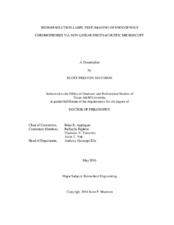| dc.description.abstract | Molecular specific subcellular imaging of biological tissues is vital for understanding the mechanisms of various pathologies. Current technologies for subcellular absorption contrast imaging, such as fluorescence confocal microscopy, require exogenous contrast agents to gain access to relevant biomolecules. All non-fluorescing biomolecules must therefore be tagged by a fluorescent marker to be visible in fluorescence confocal images. While these markers are effective, they can change the local environments, and any exogenous contrast agent must first achieve FDA approval for wide-spread use in humans.
Photoacoustic microscopy (PAM) is a hybrid imaging modality combining optical absorption imaging with ultrasonic detection capable of endogenous absorption contrast. Unfortunately, traditional photoacoustic microscopy suffers from poor axial resolution, precluding it from three-dimensional subcellular imaging. High axial resolution may be lent to PAM through the addition of a pump-probe spectroscopy technique known as transient absorption. This high resolution PAM technique, known as transient absorption ultrasonic microscopy (TAUM) enables three-dimensional subcellular imaging of endogenous biomolecules.
The pump-probe spectroscopy properties inherent to TAUM provide optically resolved point spread functions, access to ground state recovery time, and access to transient absorption spectrum measurements. This manuscript describes the author’s efforts to improve the processing capabilities of both PAM and TAUM.
In this manuscript various TAUM systems are designed and characterized in detail. A second generation TAUM system improves the processing speed of TAUM to enable processing in parallel with data acquisition. Following the improvements to processing, a novel optical schematic of TAUM is developed, greatly simplifying the design requirements of TAUM images. This system is validated by collecting volumetric images of erythrocytes in blood smears. This work enables any PAM system to be converted to a TAUM system through the addition of an optical modulator. The culmination of this work is a multispectral TAUM system hybridized with a confocal microscope to enable high resolution imaging with both scattering and absorption contrast of biological tissues. The capabilities of this PAM and TAUM are demonstrated by obtaining high resolution images of the endogenous chromophores: hemoglobin, melanin, and cytochrome C. | en |


